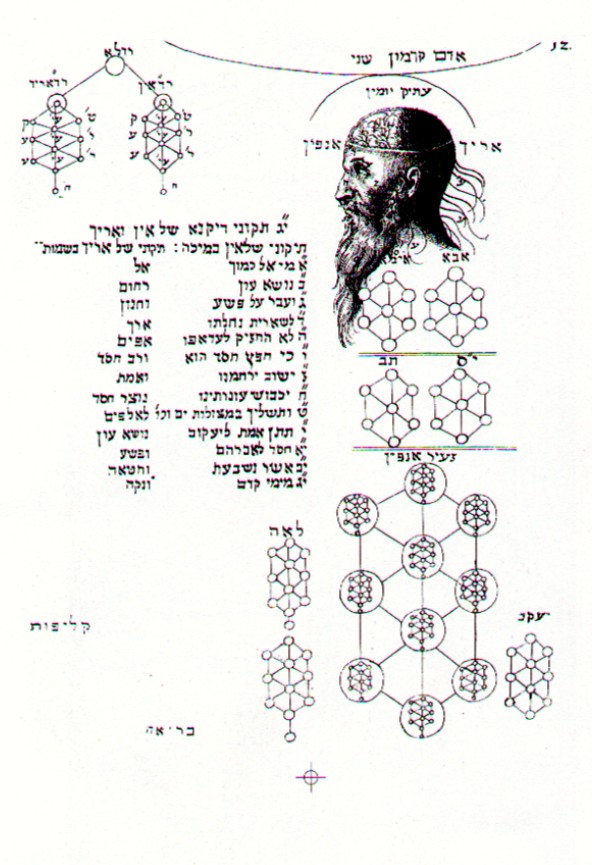
|
|
The Lurianists held that the Sefirot, in all worlds but the World of Points, are organized into Partzufim, "Visages" or personal aspects of Adam Kadmon, the Primordial Adam. According to Moses Luzatto, both the Sefirot and Partzufim are constructed of ten lights (representing each of the ten Sefirot), each of which are themselves constructed of ten more, and so on ad infinitum. However, when only a single light is illuminated in a vessel, we have a Sefirah, but when all of the lights are illuminated a Partzuf appears (Luzzatto, General Principles of the Kabbalah, p. 45. According to Chayyim Vital, a Partzuf is an aspect or "face" of the divinity, structured like a person with "248 limbs" and arranged in a pattern encompassing all ten Sefirot. The first Sefrah, Keter is the skull of the Partzuf. The next three Sefirot, Chochmah, Binah, and Da'at (Wisdom, Understanding and Knowledge) are the "three brains" which are figuratively contained inside the head. Chesed and Gevurah (Kindness and Judgment) are the right and left arms, while Tiferet (Beauty, Compassion) is the torso. Netzach and Hod are the two thighs and Yesod the phallus. Significantly, Vital describes Malchut (which is often identified with the feminine aspect of god, the Shekhinah) as the Partzuf's "female," reflecting the ancient and biblical notion that originally male and female were joined together in a single "complete" person. Although each Partzuf contains all 10 Sefirot, specific Sefirot are identified with particular Partzufim. The six major Partzufim, into which the Sefirot are reorganized are Attika Kaddisha or Arich Anpin (The Holy Ancient One or Long Suffering One) which is identified with the Sefirah Keter, Abba (the Supernal Father ) corresponding to Chochmah, Imma (the Supernal Mother) corresponding to Binah, Ze'ir Anipin (The Short-faced One) or Ben (the Son) corresponding to the Sefirot from Chesed to Yesod and Bat (the Daughter) or Nukvah (the Female) (corresponding to Malchut). Vital informs us that in the feminine Partzufim, the Sefirah Yesod, which is the phallus in the male, is the womb and female genitalia. Sometimes Atika Kadisha is spoken of as a separate Partzuf above Arich Anpin, bringing the total number of Partzufim to six. There are also six secondary Partzufim: Jacob and Israel, which are aspects of Ze'ir Anpin, Rachel and Leah, which are aspects of Nukvah, and Israel Sava and Tevunah, which respectively personify the "Malchut" of Abba and Imma.) The Partzufim, like the Sefirot are said by Vital to be the components of the cosmos. Each thing in the world is composed of the various Partzufim, which appear in infinite relations and combinations. Vital tells us that like the constellations in the sky, the Partzufim are continually changing their positions, and the procession of earthly events are a resukt of these changes The Partzufim also engage in regular sexual and procreative relations, whichhave implications for the restoration and repair of the worlds. For example, Abba and Imma (the Celestial Father and Mother) are mates, who alternately engage in "face to face" relations or turn their backs upon one another. The state of their relatedness, which is at least in part dependent upon the worship and ethical deeds of humankind, has a major impact on the flow of divine energy throughout all the worlds. Abba and Imma are also said to produce Ze'ir Anpin, who is said to develop in the womb of the Celestial mother. This procreation also contributes to Tikkun ha-Olam. The reorganization of the Sefirot into Partzufim places the Sefirot into a dialectical and procreative frame in which the creation and renewal of the world is a function of the union of God's masculine and feminine aspects. The Zohar's discussion of the relationships between the various Partzufim (the various connections and jealousies between Mother/Son and Father Daughter) in a manner that is remarkably premonitory of the Oedipal triangles later described by Freud. As discussed in "Jung and the Kabbalah", the Partzufim also anticipate the Jungian archetypes of the Senex, Mother, Father, Puer, and Maiden, each of which corresponds to one of the five main Kabbalistic visages. The symbolism of the Partzufim is a further development of the Kabbalistic notion of Adam Kadmon, Primordial Man, and illustrates the notion that the world as a whole mirrors and is mirrored in the erotic, psychic and personal life of humankind. The Partzufim are discussed in Chapters 4 and 7 of Symbols of the Kabbalah. If you entered this site via a search engine, and there are no "flash contents" on the left hand side of your screen, the site will function better if you click here and go directly to www.newkabbalah.com and follow the instructions at the bottom of your screen to either enter the site or load Flash 4, if you do not already have it. The Partzufim: Divine Visages
|
|
|
Home | Lurianic Kabbalah | Books | Articles |
Interviews | Dialog | New Projects
Jung and the Kabbalah | Jewish Review | Author Bio | Links | Tikkun/Tzedakah |
